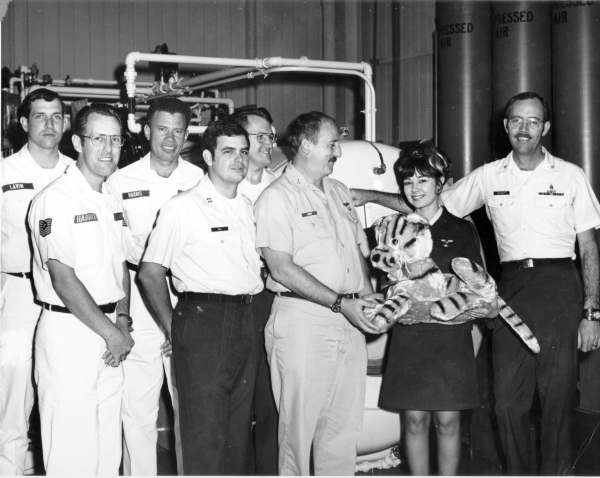|
|
(The following was excerpted from the 25 April 1997 Discovery Magazine)
"Put a Tiger in your tank" or is it "on your tank?" For 25 years the Davis Hyperbaric Laboratory staff has taken the famous Exxon slogan to heart — sort of.
Once perched atop the door to the main 11-person hyperbaric chamber, a stuffed toy tiger symbolizes the spirit of several generations of professionals who have worked to help save or improve the quality of life for thousands of people.
On 12 Jan 1997, the Armstrong Lab team marked the 25th anniversary of the dedication of 'The Royal Order of Tank Tigers."
Col. Jim Dixon, chief of Hyperbaric Medicine, said, "It was a spur of the moment idea. We agreed we ought to celebrate this." What Dixon refers to is the day in 1972 when the tiger was gifted to the lab team for saving a patent's life. The 'Tank Tiger' team concept arose in the mid '60s when chamber technicians were so anointed by Dr. Jeff Davis. Tank Tiger artwork was commissioned for the USAF in the late 60's (if anyone knows the location of the original, please contact us at 210 536-3281, or contact the Brooks OSI at 210 536-2612) showing a bengal tiger perched high atop a hyperbaric chamber.
Retired Air Force veteran Eugene Sekinger was part of the seven-member team who saved Capt Joyce Olsen's life. "She was a flight nurse and a student here. During her altitude chamber flight she developed decompression sickness. She had to receive a five-hour treatment in a hyperbaric tank," recalls Sekinger.
Sekinger, a U.S. Air Force School of Aerospace Medicine flight physiology instructor at the time, said Olsen thanked the team who treated her by giving them the tiger. "At the time, Exxon had promoted their slogan 'put a tiger in your tank.' She also considered us 'tigers' in working to save her life," Sekinger said.
While the actual 2tth anniversary of Olsen's gift occurred in January, the recent discovery of an old photo prompted last week's ceremony.
Sekinger's son Gino, Hyperbaric Lab NCOIC, said a records review uncovered a photo of the 1972 tiger gift ceremony.
TSgt. Sekinger said the photo features his father, Olsen and the rest of the hyperbaric team led by Dr. Jared Dunn, who today serves on Methodist Hospital's Hyperbaric physicians staff.

Capt. Barbara Susen, hyperbaric clinical education coordinator, said the tiger was removed recently from its perch and mounted in a commemorative display case.
"It has been placed in a more prominent position, sitting over the side of the port hole to the main chamber," she said.
Over the years, the tiger has become a mascot to thousands of patients. "Patients who graduate from their chamber treatments are given a certificate which states they are members of the Royal Order of the Tank Tiger," Susen noted. Featuring a tiger illustration, the certificate also contains data associated with a military or civilian patient's chamber treatments including pressure and depth statistics. Susen said patients range from air crew members victimized by decompression sickness to civilian victims of carbon monoxide poisoning.
Sekinger Sr. recalled a moment in chamber history that epitomizes the spirit of Royal Order of Tank Tiger members . "A Marine Corps veteran had been riding in a jeep in Vietnam when it hit a land mine. The explosion threw him into a rice patty. He was burned over most of his body. He was evacuated to Brooke Army Medical Center.
However, he was in such bad shape the doctors though the would die. A grave, containing a headstone, had already been dug for him at Fort Sam Houston," Sekinger explained.
As a last resort, the Marine was taken to Brooks for hyperbaric treatment on Thanksgiving Day. He survived.
Sekinger says, "He came back to visit us and thank us. It was one of the most rewarding experiences of my life."
The tiger always evokes stones of courage and sacrifice, allowing the hyperbaric lab team the latitude of saying, "tanks for the memories."
Post Script:
It was with great sadness that the Davis Hyperbaric Laboratory noted the passing of Dr. Jared Dunn in the early Summer of 1998. He was a visionary pioneer in the re-emergence of hyperbarics as a beneficial treatment program for thousands of otherwise untreatable patients.
